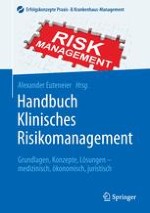Zusammenfassung
Ohne Einsatz effektiver Analyse- und Reportingwerkzeuge kann kein klinisches Risikomanagement (RM) erfolgen. Viele Methoden und Werkzeuge werden teils noch als Insellösungen eingesetzt oder sind in Erprobung, wobei die USA in Bezug auf den Umsetzungsgrad eine Vorreiterrolle einnehmen. Verfahren mit langer ärztlicher Tradition wie M&M-Konferenzen und Peer-Reviews werden für das RM wieder entdeckt. Der Einsatz von IT und RM-Software ermöglichen u. a. die automatische Auswertung von Kenngrößen (GTT, PSI). Methoden wie CIRS, Fehlerursachenanalysen (RCA, London-Protokoll), Befragungen, Audits und diverse Beurteilungsverfahren einzelner Mitarbeiter, erfassen und analysieren nicht nur Risiken, sondern entfalten bereits alleine durch ihren Einsatz große Wirkung auf die Sicherheitskultur und ihren Ausprägungen wie Kommunikation und Führungsverhalten. Szenarioanalysen und ganzheitliche Bewertungen klinischer Risikomanagement-Systeme stehen erst am Anfang ihres flächendeckenden Einsatzes.











